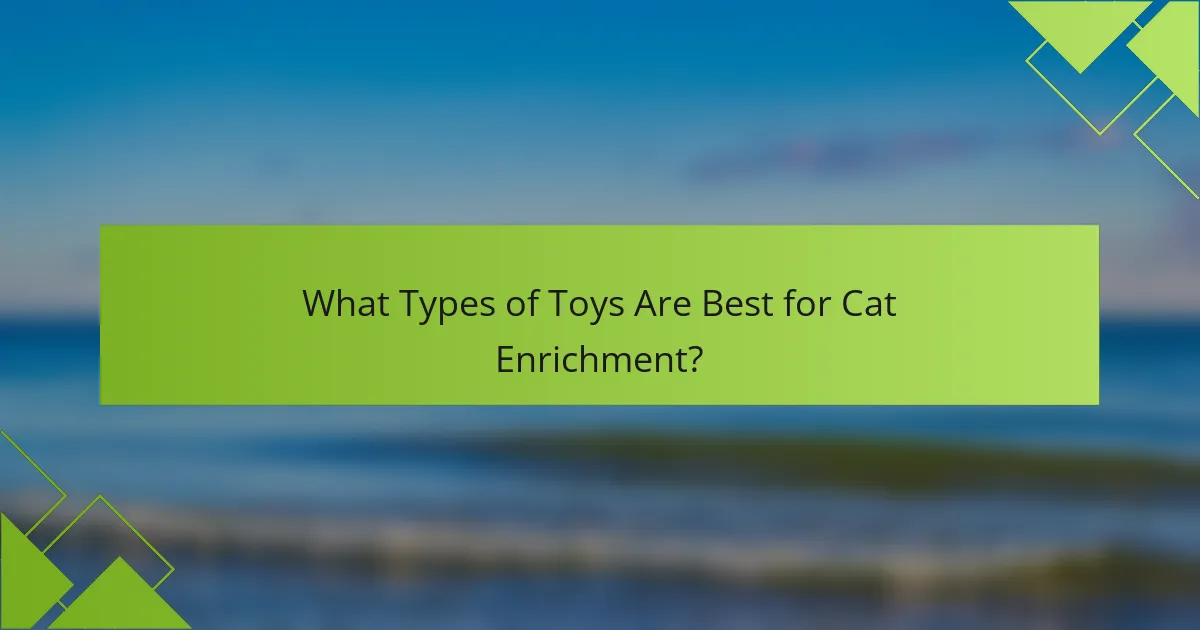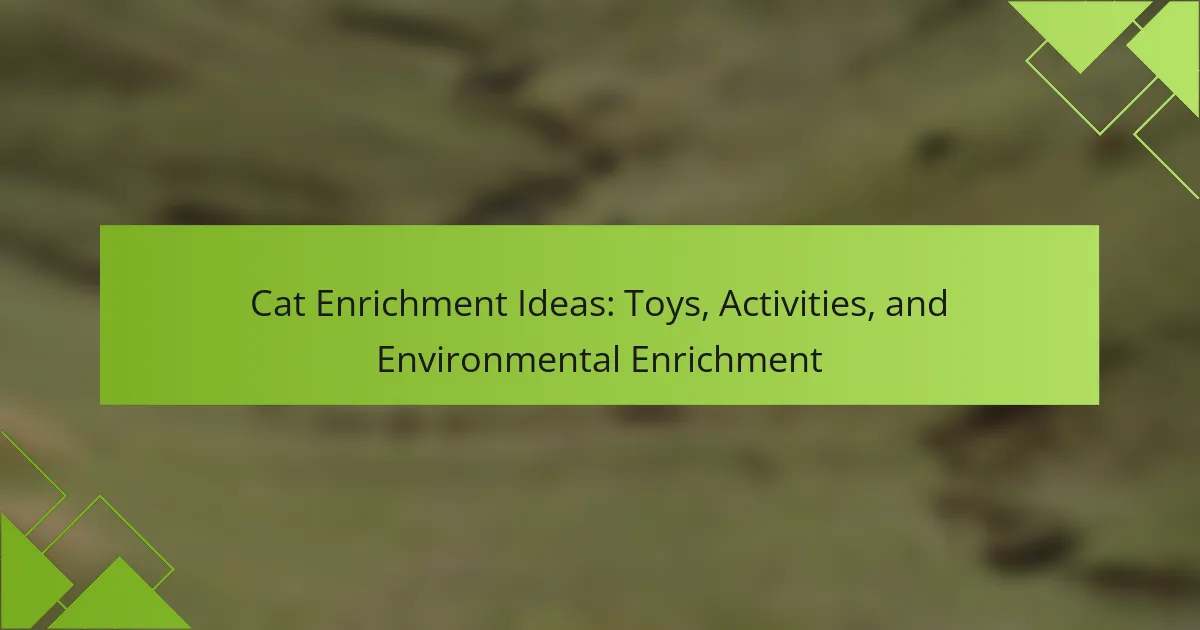Cat enrichment is essential for enhancing their well-being and reducing stress. This article explores interactive toys, engaging activities, and environmental setups that stimulate their natural instincts. Discover how to create a diverse play environment, incorporate sensory stimulation, and avoid common enrichment mistakes to ensure a happy, healthy cat.

Why is Cat Enrichment Important for Well-Being?
Cat enrichment is crucial for well-being because it stimulates physical and mental activity. Enriched environments reduce stress and behavioral issues in cats. Engaging toys, interactive activities, and varied surroundings promote natural instincts, enhancing overall happiness. For example, puzzle feeders can challenge their minds while providing rewards.
What Are the Benefits of Enrichment for Cats?
Enrichment provides numerous benefits for cats, enhancing their physical and mental well-being. Engaging toys and activities stimulate natural instincts, reducing boredom and stress. Improved cognitive function and physical health result from varied environments, promoting active play and exploration. Enhanced bonding occurs through interactive experiences, fostering a happier, more fulfilled pet.
How Does Enrichment Impact Cat Behavior?
Enrichment significantly enhances cat behavior by reducing stress and promoting mental stimulation. Engaging toys, interactive activities, and diverse environments encourage natural instincts and improve overall well-being.
For example, puzzle feeders stimulate problem-solving skills, while climbing structures satisfy a cat’s desire to explore vertical spaces. Regular playtime fosters bonding and helps prevent behavioral issues like aggression or anxiety.
Environmental enrichment, such as providing scratching posts and cozy hiding spots, creates a more fulfilling habitat. As a result, enriched cats exhibit increased activity, curiosity, and happiness.
Which Factors Influence a Cat’s Need for Enrichment?
Several factors influence a cat’s need for enrichment, including age, personality, and environment. Younger cats typically require more stimulation due to their higher energy levels. Individual personality traits, such as curiosity or playfulness, also dictate enrichment needs. Additionally, a cat’s living environment, including space and available resources, significantly affects its enrichment requirements.

What Types of Toys Are Best for Cat Enrichment?
Interactive toys, puzzle feeders, and catnip-infused items are best for cat enrichment. These toys stimulate mental and physical activity, promoting overall well-being.
Interactive toys, such as feather wands, encourage active play and hunting instincts. Puzzle feeders challenge cats to work for their food, enhancing problem-solving skills. Catnip-infused toys engage their senses and provide comfort.
Providing a variety of these toys can prevent boredom and destructive behavior, ensuring a happy, healthy cat. Regular rotation of toys keeps the environment stimulating and engaging.
How Do Interactive Toys Enhance Playtime?
Interactive toys significantly enhance playtime by stimulating a cat’s natural instincts and promoting physical activity. These toys provide mental engagement, reducing boredom and destructive behavior. For example, toys that mimic prey movements encourage hunting behaviors, fostering both physical and cognitive development. Additionally, interactive toys can strengthen the bond between cats and their owners, as they often require human participation for optimal engagement. This interaction enhances social skills and enriches the overall play experience.
Which Types of Puzzle Toys Are Popular Among Cats?
Interactive puzzle toys, treat-dispensing toys, and ball-based toys are popular among cats. These types of toys stimulate mental engagement and promote physical activity. Interactive puzzle toys challenge cats to solve problems to access hidden treats. Treat-dispensing toys reward cats with food as they play, encouraging exploration. Ball-based toys provide opportunities for chasing and batting, which satisfies natural hunting instincts. Each of these toys enhances cat enrichment by providing varied forms of play and mental stimulation.
What Are the Advantages of DIY Cat Toys?
DIY cat toys offer numerous advantages for both cats and their owners. They are cost-effective, promote mental stimulation, and encourage physical activity. Creating toys from household items reduces waste and fosters creativity. Engaging in DIY projects strengthens the bond between the owner and the cat, enhancing overall enrichment.

How Can Activities Improve a Cat’s Quality of Life?
Engaging activities significantly enhance a cat’s quality of life. They stimulate mental and physical health, reduce boredom, and prevent behavioral issues.
Interactive toys, such as feather wands and laser pointers, encourage exercise and play. Puzzle feeders challenge cats mentally while providing food rewards, promoting natural hunting instincts.
Environmental enrichment, like cat trees and scratching posts, offers safe spaces for climbing and scratching. Regularly rotating toys and introducing new activities keeps the environment fresh and exciting for cats.
Social interaction through playtime strengthens the bond between cats and their owners, contributing to overall happiness.
What Are Engaging Indoor Activities for Cats?
Engaging indoor activities for cats include interactive toys, puzzle feeders, and climbing structures. These activities stimulate mental and physical exercise, enhancing a cat’s well-being.
1. Interactive Toys: Toys that respond to a cat’s actions keep them engaged.
2. Puzzle Feeders: These challenge cats to solve problems for treats, promoting mental stimulation.
3. Climbing Structures: Cat trees or shelves encourage climbing and exploration.
4. Laser Pointers: Chasing a laser light provides physical exercise and excitement.
5. Hide and Seek: Hiding treats or toys encourages natural hunting instincts.
6. DIY Activities: Creating homemade toys from simple materials can be cost-effective and fun.
How Can Outdoor Exploration Benefit Cats?
Outdoor exploration significantly benefits cats by enhancing their physical and mental well-being. Engaging in outdoor activities stimulates their natural instincts, encourages exercise, and reduces stress. Cats exposed to varied environments experience improved socialization and cognitive skills. Additionally, outdoor exploration can lead to a healthier lifestyle, reducing obesity risks associated with indoor-only living.
Which Social Activities Foster Bonding with Cats?
Engaging in interactive activities fosters bonding with cats. Playtime with toys, such as feather wands or laser pointers, enhances their hunting instincts and builds trust. Creating a stimulating environment with climbing structures and hiding spots encourages exploration and interaction. Regularly scheduled cuddle sessions and gentle grooming can also strengthen the emotional connection between cats and their owners.

What Environmental Enrichment Strategies Can Be Implemented?
Implementing environmental enrichment strategies enhances a cat’s quality of life. Effective strategies include interactive toys, climbing structures, and sensory stimulation through varied textures and scents.
1. Interactive Toys: Puzzle feeders and wand toys engage cats mentally and physically.
2. Climbing Structures: Cat trees and shelves provide vertical space for exploration and exercise.
3. Sensory Stimulation: Incorporate different textures and scents using safe plants and materials.
4. Play Areas: Designate spaces for play with various toys to encourage activity and reduce boredom.
5. Safe Outdoor Access: Catios or supervised outdoor time can enrich a cat’s environment significantly.
How Does Habitat Design Affect Cat Enrichment?
Habitat design significantly influences cat enrichment by providing stimulating environments. A well-designed space encourages natural behaviors like climbing, scratching, and exploring.
Vertical spaces, such as shelves and cat trees, enhance play and exercise, while hiding spots promote security. Incorporating varied textures and scents further enriches the environment, catering to a cat’s sensory needs.
Enriched habitats lead to improved mental health and reduced stress, fostering a happier, more active cat.
What Role Do Vertical Spaces Play in Cat Enrichment?
Vertical spaces significantly enhance cat enrichment by providing opportunities for climbing, exploring, and observing. Cats are natural climbers, and vertical spaces stimulate their instincts, encouraging physical activity and mental engagement.
These spaces can include shelves, cat trees, and wall-mounted perches, which promote exercise and reduce boredom. Elevated areas allow cats to survey their environment, contributing to their sense of security and well-being.
Incorporating vertical spaces into a cat’s environment can lead to improved physical health and reduced behavioral issues. Engaging with these structures satisfies their curiosity and enhances their overall quality of life.
Which Sensory Experiences Are Beneficial for Cats?
Sensory experiences beneficial for cats include interactive toys, varied textures, and engaging scents. These elements stimulate mental and physical activity, enhancing overall well-being.
Toys with different textures, such as crinkly or fuzzy materials, promote tactile exploration. Engaging scents, like catnip or pheromone-infused products, can attract and calm cats. Interactive activities, such as puzzle feeders or laser pointers, provide mental stimulation and exercise.
Incorporating diverse sensory experiences into a cat’s environment can reduce stress and prevent behavioral issues. Regularly rotating toys and activities maintains interest and encourages exploration.

How Do Regional Preferences Shape Cat Enrichment Ideas?
Regional preferences significantly influence cat enrichment ideas by reflecting cultural values and available resources. Different regions prioritize specific toys, activities, and environmental setups based on local climate, lifestyle, and pet ownership trends. For example, in colder climates, indoor enrichment options like interactive toys and climbing structures are popular, while warmer areas may favor outdoor activities, such as exploring gardens.
Additionally, cultural attitudes toward pets shape enrichment choices. In some regions, cats are viewed as family members, leading to more elaborate enrichment setups, while in others, simpler toys suffice. Understanding these regional nuances helps tailor enrichment strategies that resonate with local pet owners, ensuring cats receive appropriate stimulation.
Lastly, economic factors also play a role. Regions with higher disposable income may have access to premium enrichment products, while others might rely on DIY solutions. This diversity in preferences highlights the need for adaptable enrichment ideas that cater to various cultural and economic contexts.
What Unique Enrichment Ideas Are Popular in Different Cultures?
Cultural enrichment ideas for cats vary widely, reflecting local customs and available resources. In Japan, interactive toys like feather wands are popular, promoting physical activity. In Italy, cat cafes offer social interaction and environmental stimulation, enhancing mental well-being. Scandinavian countries emphasize natural elements, incorporating climbing trees and scratching posts made from untreated wood. In the United States, puzzle feeders are common, encouraging problem-solving and engagement. Each culture adapts enrichment to its unique lifestyle and environment, benefiting feline companions.
How Can Local Resources Enhance Cat Enrichment Options?
Local resources can significantly enhance cat enrichment options by providing unique, accessible materials and activities. Utilizing items from your environment, such as cardboard boxes or natural elements, encourages creativity and engagement. Additionally, local workshops or pet community events often offer interactive experiences that stimulate a cat’s senses. Collaborating with nearby businesses, like pet stores, can yield innovative toys and enrichment tools tailored to your region. These resources not only enrich the cat’s environment but also foster community connections.

What Common Mistakes Should Be Avoided in Cat Enrichment?
To enhance cat enrichment effectively, avoid common mistakes like offering inadequate stimulation, neglecting safety, and failing to vary activities.
1. Insufficient Variety: Cats need diverse toys and activities to prevent boredom.
2. Ignoring Safety: Always choose non-toxic materials and avoid small parts that can be swallowed.
3. Lack of Interaction: Engage with your cat during playtime to strengthen your bond and enrich their experience.
4. Overlooking Preferences: Pay attention to your cat’s unique likes and dislikes to tailor enrichment effectively.
5. Inconsistent Environment: Regularly change the layout or introduce new elements to keep their environment stimulating.
6. Underestimating Space: Ensure your cat has enough physical space to explore and play safely.
How Can Overstimulation Be Managed in Enrichment Activities?
Overstimulation in enrichment activities can be managed by providing a balanced mix of toys and activities. Gradually introduce new stimuli, allowing your cat to acclimate. Observe their behavior closely; if signs of stress appear, reduce the intensity or frequency of activities. Create a safe space where your cat can retreat if overwhelmed. Incorporate interactive play sessions that allow for breaks, ensuring your cat remains engaged without becoming overstimulated.
What Are the Signs of Insufficient Enrichment for Cats?
Signs of insufficient enrichment for cats include boredom, destructive behavior, excessive vocalization, and weight gain. These behaviors indicate a lack of mental and physical stimulation. For example, a cat may scratch furniture or knock over objects if it lacks engaging toys or activities. Providing diverse enrichment options can help address these signs effectively.
Which Best Practices Ensure Effective Cat Enrichment?
To ensure effective cat enrichment, provide a variety of stimulating toys, interactive activities, and a dynamic environment. Incorporate scratch posts, climbing structures, and puzzle feeders to engage their natural instincts. Regularly rotate toys to maintain interest and introduce new challenges.
